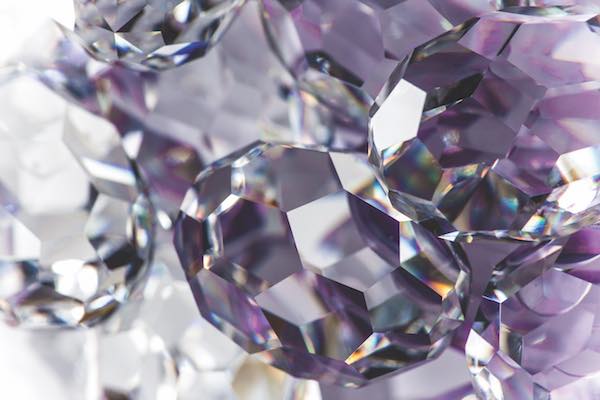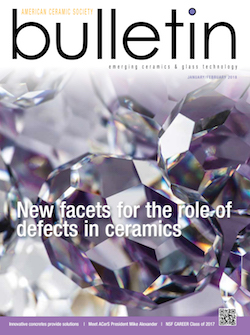
The January/February 2018 issue of the ACerS Bulletin is now available online—and it’s a gem.
The new issue of the new year features a cover story all about new facets for the role of defects in ceramics. Written by S. Saremi, R. Gao, A. Dasgupta, and L.W. Martin, the article details ceramic materials’ ongoing public relations problem—they’ve too long been viewed as the “bad guys.” But with advances in the ability to synthesize, characterize, and model materials, it may finally be time to redefine the negative connotation surrounding defects in ceramic materials. Defects don’t have to be bad—in fact, they generate value when it comes to gem-quality diamonds. Specific crystalline defects cause varied colorations and often add value, rather than detract from it, in these coveted gemstones (turn to page 16 of the new issue to learn more). Likewise, defects can offer novel opportunities in engineering ceramic materials.
The January/February issue also features another interesting article all about cements. Rouzbeh Shahsavari and Sung Hoon Hwang provide us an expert perspective on innovative concretes and how they might be able to combat rising construction costs and environmental footprint of the most widely used synthetic material in the world. Cement consumption has skyrocketed in the past century, and the costs of building, maintaining, and replacing concrete keep increasing. Plus, the energy and environmental costs of our concrete infrastructure are high as well—current concrete manufacturing generates 8–9% of global anthropogenic CO2 emissions and consumes 2–3% of global primary energy. But, as Shahsavari and Hwang detail in the article, additive methods, nanostructure control, computational modelling, self-healing additives, and renewable byproduct raw materials will help cement scientists engineer stronger and more durable concretes—with less global societal cost.
Plus, don’t miss this opportunity to meet ACerS new president, Mike Alexander, in this issue. Learn a bit more about Alexander and his plans for the next year at the helm of the Society. Alexander says he’s surprised by his whole career trajectory—and you might be surprised to learn about his original career plans before he found refractories.
The issue also includes an introduction to the new NSF CAREER awardees in Ceramics. NSF’s CAREER program supports junior faculty who meld research and education efforts. Lynnette D. Madsen introduces us to the impressive research and engagement activities of the Class of 2017: Matthew McDowell, Luiz Jacobsohn, and Jessica Krogstad.
And does your company export? Whether the answer is yes or no, you won’t want to miss a special column about exporting by Deborah Dirr. Dirr is an international trade specialist with the U.S. Commercial Service, which helps companies export and supports American business interests abroad. Whether a company is brand new to the export game or looking to hone existing export activities, U.S. Commercial Service offers tailored export assistance to companies through various resources.
There’s lots more good stuff inside this—and every issue—of the ACerS Bulletin. The current issue is free to all for a short time, but remember that all the valuable content in over ninety years of past issues of the ACerS Bulletin is free only to members—so considering joining us today!
Did you find this article interesting? Subscribe to the Ceramic Tech Today newsletter to continue to read more articles about the latest news in the ceramic and glass industry! Visit this link to get started.

